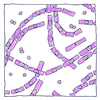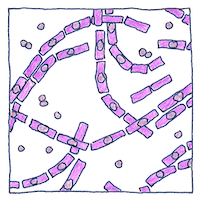Aloys Pollender,
Casimir Davaine,
Pierre François Olive Rayer,
Robert Koch
bacteriology

|
Bacillus anthracis
Robert Koch was the first to prove that a specific microorganism causes a specific disease, specifically, that bacillus anthracis causes anthrax. Pollender, Davaine, and Rayer before him found bacillus anthracis in diseased animals, described the bacterium, and even asserted that it caused the disease. Bacillus anthracis forms hardened spores that survive in soil for many years and when the spores get into an animal they grow, produce toxins, and release more spores.
Strains
There are 89 strains, some of which have been manufactured as biological weapons and some of which have been used to develop vaccines or to test the effectiveness of vaccines. Roy Vollum developed the Vollum strain in 1935 from a cow in Oxfordshire. Britain increased its virulence by infecting 36 macaques, isolating it from each. The U.S. sold Vollum M36 to Sadam Hussein. Other weaponized strains were Anthrax 836, collected in Kirov and weaponized by the Russians in 1953, and the Ames strain, collected from a heifer in Texas in 1981. Letters sent to newsmen and senators in 2001 contained the Ames strain.
Spores
Spores may lay long dormant Seeds of squash buried in a pot An original attachment A physical connection A different identity A new strain Back in the ground.



Never underestimate the ability of modern science to take a bad thing and make it worse. Yet science also uses new information to improve people’s lives. Some b. anthracis strains have been used to create anthrax vaccines. Currently these are available in the U.S. only for the military and for at-risk occupations. For the general public, the appropriate way to control anthrax is by controlling its incidence in livestock.
See also in The book of science:
Readings in wikipedia:
Other readings: